This year’s annual report of the European Fiscal Board provides new evidence that the EU fiscal framework does not deliver the goods. This column argues that it should be reformed without delay.
As forging consensus among EU member states takes time, the activation
of the general escape clause until end-2021 offers a window of
opportunity to build a simpler, leaner and more effective fiscal
contract. The year 2019 illustrated once again how EU member states
largely failed to build buffers in good times, those very buffers that
would have been welcome in the face of the Covid-19 shock. In 2019, and
despite sustained economic growth, the aggregate EU government deficit
has increased for the first time since 2011 while cases of
non-compliance with the preventive arm of the Stability and Growth Pact
(SGP). Like other common shocks before, the pandemic has exposed three
long-standing gaps in EMU’s architecture: (1) the lack of a genuine and
permanent central fiscal capacity; (2) adverse incentives to maintain or
scale up growth-enhancing government expenditure; (3) an intractable
set of rules and benchmarks poorly tailored to country-specific debt
reduction needs and capacities.
On 20 October 2020, the European Fiscal Board published its new annual report. The
report provides a careful assessment of 2019 and puts forward ideas on
how to strengthen the EU fiscal framework. The year 2019 marked the end
of a six-year long recovery from the financial and sovereign debt
crises. Although slowing, economic growth settled at around 1.5%, in
line with its estimated potential. Overall, last year still qualifies as
good economic times, with the level of economic activity at or above
potential in the vast majority of EU countries. Despite sustained
economic growth, the aggregate fiscal position of both the euro area and
the EU weakened by around 0.25% of GDP as measured by the structural
primary budget balance (Figure 1). The deterioration of public finances
largely resulted from expenditure slippages, which more than offset
savings on interest payments.
Moreover, spending
increases highlight failures to stick to budgetary plans. In the EU as a
whole, public expenditure turned out 1.2 % of GDP higher than envisaged
in governments’ medium-term budgetary plans, i.e. the Stability and
Convergence Programmes presented in spring 2018. Sizeable slippages took
place in countries with high or very high debt levels. Furthermore, in
2014-2019 the largest part of expenditure slippages went into current
expenditure and only a very small fraction – less than one tenth – was
allocated to government investment (Figure 3).
Figure 1 Drivers of the change in the headline balance, euro area
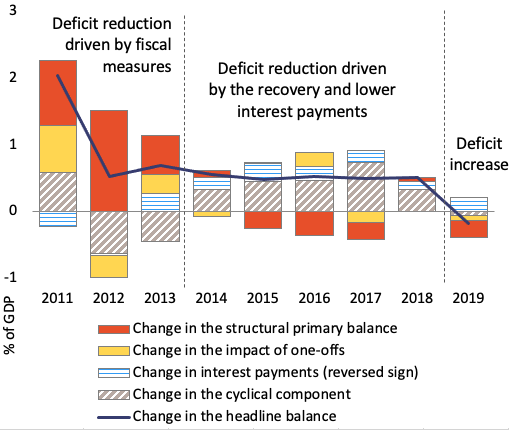
Source: European Commission; own calculations
Figure 2 Euro area output gap and fiscal stance
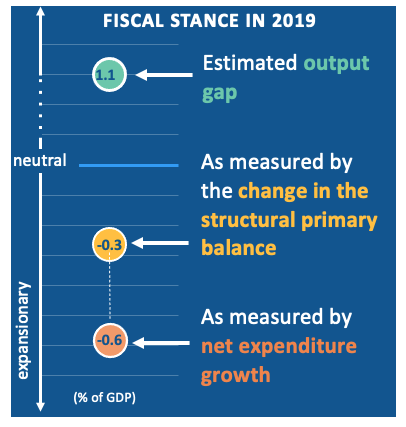
Figure 3 Government expenditure slippages, EU (2016-2019)
a) By government debt level
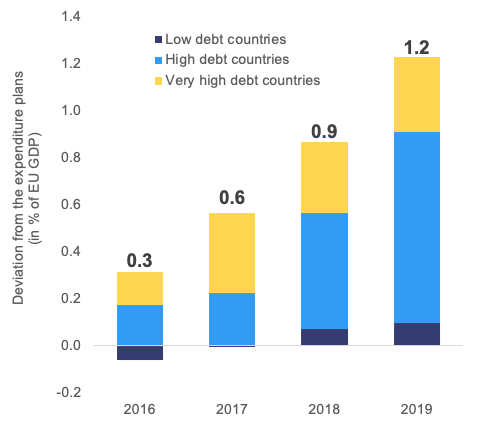
b) By type of government expenditure
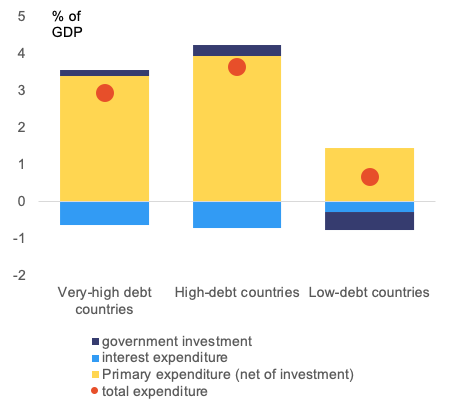
Notes:
(1) The figure shows the difference between government expenditure
outturn and spending plans in the stability and convergence programmes
over 2016-2019 as a share of GDP. (2) The classification of countries by
debt level is based on the average debt-to-GDP ratio over 2016-2019.
Very high-debt countries = above 90% of GDP (i.e. BE, ES, FR, IT, CY,
PT); High-debt countries = between 60% and 90% (i.e. DE, IE, HR, HU, NL,
AT, SI, UK); Low-debt countries = below 60% (i.e. BG, CZ, DK, EE, LV,
LT, LU, MT, PL, RO, SK, FI, SE). Share in EU GDP: low-debt group (18%),
high-debt group (44%), very high-debt group (38%).
Source: European Commission; own calculations
A record number of non-compliant cases with no follow up
In its final
assessment, the Commission found that ten countries fell short of the
SGP’s required fiscal adjustments by a large margin (i.e. Belgium,
Estonia, Spain, France, Hungary, Poland, Portugal, Slovenia, Slovakia,
and the UK) while three failed to reduce their high debt levels at the
required pace (Belgium, France, and Spain). In early 2020, an excessive
deficit procedure (EDP) was opened only for Romania due to a planned
breach of the 3% of GDP deficit reference value in 2019. The number of
countries significantly deviating from the rules in 2019 was the highest
since the six and two-pack legislative reforms of 2011-2013. Similarly,
the size of the deviations was the highest since 2014 (Figure 4). Once
again, many governments failed to take advantage of good economic
conditions to build buffers.
Figure 4 Deviations from fiscal requirements (2014-2019)
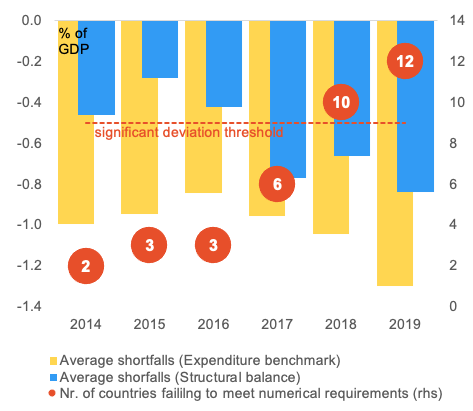
Notes:
(1) A country is considered to fall short of its requirement under the
preventive arm of the SGP when both the established compliance
indicators (i.e. the structural balance and the expenditure benchmark)
show a deviation from the MTO or from the adjustment towards it. (2) The
chart excludes countries in EDP.
Source: European Commission; own calculations
The spread of the
COVID-19 pandemic in the spring of 2020 radically changed conditions.
Triggered by the sanitary measures aimed at containing the spread of the
virus, the deepest recession since the Great Depression was met by
massive fiscal expansions in all countries. The economic and social
impact of the pandemic fully justified the activation of the general
escape clause of the SGP, allowing governments to respond to the crisis
as they saw fit. Although the clause does not apply to 2019, the
Commission and the Council agreed that the exceptional impact of the
pandemic in 2020 did not warrant any action related to widespread
non-compliance the year before. The conditions under which the clause
would be de-activated should nevertheless be clarified soon enough to
keep fiscal expectations well anchored.
Reforming the pact
Before the COVID-19
pandemic wreaked havoc on public finances in the EU, the effectiveness
of the fiscal rules had already been put into question. In the
relatively favourable years up to and including 2019, deficiencies in
the rules became evident: complications and ambiguities; pro-cyclical
fiscal policies; and declining government investment. The EFB (2019)
provided an extensive overview of these weaknesses. Our review of the
most recent experience confirms this assessment, not least with respect
to the inability to build fiscal buffers in good times.
The Commission’s
economic governance review of 5 February 2020 launched a debate on how
to improve the SGP. With the aggregate euro area and EU deficit now
expected to surge from just 0.6% of GDP in 2019 to around 8.5% in 2020
and debt ratios at historic highs, the Commission’s review and
consultation will take place in a completely new context with
potentially far-reaching implications. From the current perspective, the
long-standing deficiencies seem even more obvious: non-observable
short-term policy indicators such as the structural balance are
surrounded by even higher uncertainty; the responsibility for sustaining
investment has temporarily been assumed by the NGEU, but will require
national follow-up; fiscal stabilisation subject to sustainability
constraints must be reassessed to leave more room to support demand in
the low interest-rate environment....
more at Vox
© VoxEU.org
Key

Hover over the blue highlighted
text to view the acronym meaning

Hover
over these icons for more information

Comments:
No Comments for this Article